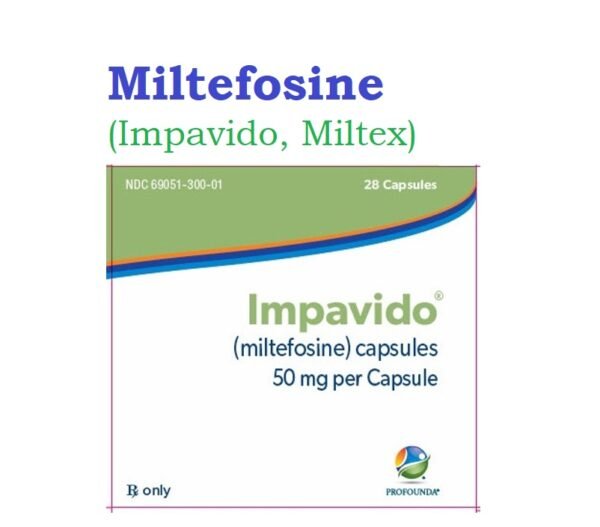Miltefosine is a medication used primarily to treat leishmaniasis, a parasitic disease caused by the Leishmania species. It's one of the few oral drugs available for the treatment of this disease. Leishmaniasis affects the skin, mucous membranes, and internal organs and can be life-threatening if left untreated.
Miltefosine works by interfering with the parasite's cell membranes, ultimately leading to its death. It's usually administered orally and has been effective in treating visceral leishmaniasis (also known as kala-azar), cutaneous leishmaniasis, and mucosal leishmaniasis.
Miltefosine (Impavido, Miltex) is currently the only available oral medicine for the treatment of leishmaniasis including cutaneous, mucosal, and visceral forms.
Miltefosine (Impavido, Miltex) Uses:
- Leishmaniasis:
- It is recommended for the treatment of cutaneous, mucosal, and visceral leishmaniasis caused by Leishmania guyanensis, L. braziliensis, L. panamensis, and L. guyanensis in adults and children older than 12 years old and weighing at least 30 kg.
- Limitations of use:
- Efficacy of miltefosine treatment in infections caused by other species such as Leishmania infantum has not been evaluated
- Off Label Use of Miltefosine in Adults:
- Free-living amebae (FLA) infections
Miltefosine Dose in Adults:
Miltefosine (Impavido, Miltex) Dose in the treatment of Leishmaniasis:
For people not infected with HIV-1:
- If you weigh between 30 and 44 kilograms: Take 50 milligrams of miltefosine twice a day for 28 days.
- If you weigh 45 kilograms or more: Take 50 milligrams of miltefosine three times a day for 28 days.
For HIV-1 positive patients with initial acute visceral infection:
- Take 100 milligrams of miltefosine orally once a day for 28 days. Please note this usage is off-label, meaning it's not specifically approved for this purpose but may be prescribed by a doctor based on their judgment.
Miltefosine (Impavido, Miltex) Dose in the treatment of Free-living amebae (FLA) infections (off-label):
- If you weigh less than 45 kilograms: Take 50 milligrams of miltefosine twice daily.
- If you weigh 45 kilograms or more: Take 50 milligrams of miltefosine three times daily.
Miltefosine Dose in Children:
Miltefosine (Impavido, Miltex) Dose in the treatment of Leishmaniasis:
For non-HIV positive or exposed individuals:
- Children aged 12 years and adolescents weighing 30 kilograms or more:
- For cutaneous, mucosal, or visceral leishmaniasis:
- If weighing between 30 and 44 kilograms: Take 50 milligrams of miltefosine twice daily for 28 days.
- If weighing 45 kilograms or more: Take 50 milligrams of miltefosine three times daily for 28 days.
- For cutaneous, mucosal, or visceral leishmaniasis:
For HIV positive or exposed adolescents:
- For treating visceral leishmaniasis during the initial acute infection:
- Take 100 milligrams of miltefosine orally once daily for 28 days. Please note that this usage is off-label, meaning it's not specifically approved for this purpose but may be prescribed by a doctor based on their judgment.
Miltefosine (Impavido, Miltex) Dose in the treatment of infections caused by Free-living amebas (Naegleria fowleri):
For children and adolescents:
- If the weight is less than 45 kilograms:
- Take 50 milligrams of miltefosine twice daily for 28 days. Ensure not to exceed 2.5 milligrams per kilogram per dose.
- In some cases, such as an 8-year-old, a dosage of 50 milligrams three times daily has been administered.
- If the weight is 45 kilograms or more:
- Take 50 milligrams of miltefosine three times daily for 28 days.
Please note that these recommendations are based on expert suggestions due to the severity of the infection and the lack of effective treatment options.
Pregnancy Risk Factor D
- Miltefosine poses serious risks to pregnancy, classified as Pregnancy Risk Factor D, meaning it's not safe for use during pregnancy.
- It's been shown to harm unborn babies in animal studies even at doses lower than those given to humans, leading to fetal death and birth defects.
- Therefore, pregnant women should not take miltefosine.
- Leishmaniasis itself can also cause complications during pregnancy, including serious risks to both the mother and the baby, such as spontaneous abortion, congenital diseases, preterm births, and stillbirths.
- Before starting miltefosine, it's crucial to confirm the absence of pregnancy through a test in females of reproductive age.
- Additionally, women of childbearing potential should use effective contraception during treatment and for five months afterward.
- If they experience nausea, vomiting, or diarrhea while taking miltefosine, they should consider using alternative contraceptive methods.
- It's worth noting that miltefosine can also affect male fertility, leading to decreased or absent ejaculation.
Miltefosine use during breastfeeding:
- It's uncertain whether miltefosine passes into breast milk.
- Since there's a risk of serious side effects in breastfeeding infants, the manufacturer advises making a choice between stopping breastfeeding or discontinuing the medication, considering how crucial treatment is for the mother.
- They also suggest avoiding breastfeeding for five months after finishing miltefosine therapy.
Miltefosine Dose in Kidney Disease:
- The manufacturer's labeling does not include dosage adjustments for individuals with kidney disease because such adjustments have not been studied.
Miltefosine Dose in Liver disease:
- The manufacturer's labeling does not include dosage adjustments for individuals with liver disease because such adjustments have not been studied.
Common Side Effects of Miltefosine (Impavido, Miltex):
- Central nervous system:
- Headache
- Dizziness
- Gastrointestinal:
- Nausea
- Vomiting
- Motion sickness
- Decreased appetite
- Diarrhea
- Abdominal pain
- Hematologic & oncologic:
- Decreased platelet count
- Hepatic:
- Increased serum transaminases
- Renal:
- Increased serum creatinine
Less Common Side Effects of Miltefosine (Impavido, Miltex):
- Central Nervous System:
- Drowsiness
- Malaise
- Fatigue
- Paresthesia
- Dermatologic:
- Pruritus
- Cellulitis
- Pyoderma
- Skin Rash
- Stevens-Johnson Syndrome
- Urticaria
- Gastrointestinal:
- Abdominal Distention
- Constipation
- Dysphagia
- Flatulence
- Genitourinary:
- Testicular Pain
- Testicular Swelling
- Hematologic & Oncologic:
- Lymphangitis
- Anemia
- Lymphadenopathy
- Infection:
- Abscess
- Ecthyma
- Neuromuscular & Skeletal:
- Weakness
- Miscellaneous:
- Fever
Contraindications to Miltefosine (Impavido, Miltex):
- Miltefosine should not be used in individuals with hypersensitivity to miltefosine or any component of the formulation.
- Additionally, it is contraindicated in individuals with Sjogren-Larsson syndrome, a rare genetic disorder.
- It should also not be used during pregnancy due to the risk of harm to the fetus.
Warnings and precautions
Dermatologic toxicities:
- Dermatologic toxicity, including serious conditions like Stevens-Johnson syndrome, has been reported with the use of miltefosine.
- If an exfoliative or bullous rash develops during treatment, miltefosine should be discontinued immediately.
Fertility effects
- Miltefosine has been found to affect fertility in both female and male animals.
- However, its effects on human fertility have not been thoroughly studied.
- Some side effects reported during miltefosine therapy include scrotal pain and decreased or absent ejaculation.
Gastrointestinal effects:
- Gastrointestinal side effects like nausea, vomiting, and diarrhea are common with miltefosine use.
- Taking the medication with food can help reduce these effects.
- It's important to maintain adequate fluid intake during therapy to prevent dehydration.
Hematologic toxicities:
- Hematologic toxicity, such as thrombocytopenia (low platelet count), has been reported during miltefosine therapy for visceral leishmaniasis.
- Patients undergoing this treatment should have their platelet count monitored regularly to detect any abnormalities.
Hepatic effects
- Hepatic effects, including elevated liver transaminases (ALT, AST) and bilirubin levels, have been observed during miltefosine therapy for visceral leishmaniasis.
- It's important to assess these liver function markers regularly during treatment to monitor for any signs of liver dysfunction.
Toxicity in the renal system:
- Miltefosine can potentially lead to renal toxicity, characterized by an increase in serum creatinine levels.
- To monitor kidney function, it's recommended to assess creatinine levels weekly while on therapy and for four weeks after completing treatment.
- This regular monitoring helps to promptly identify any changes in kidney function and ensures appropriate management if needed.
Monitoring parameters:
Liver Function Tests:
- Baseline and as clinically indicated during therapy
- Includes AST, ALT, alkaline phosphatase, and bilirubin
Kidney Function:
- Baseline and as clinically indicated during therapy
- Includes BUN (blood urea nitrogen) and serum creatinine
- Monitor weekly during therapy and for four weeks after treatment
Platelet Count:
- Regular monitoring during therapy
- Assess for thrombocytopenia (low platelet count)
How to administer Miltefosine (Impavido, Miltex)?
Administering Miltefosine Orally
With Food to Reduce GI Distress:
- Take miltefosine with food to decrease gastrointestinal discomfort.
Twice Daily Dosing:
- Take medication with breakfast and dinner.
Three Times Daily Dosing:
- Take medication with breakfast, lunch, and dinner.
Mechanism of action of Miltefosine (Impavido, Miltex):
- The exact way miltefosine works isn't fully understood, but it likely interacts with phospholipids and steroids in the cell membranes of parasites, which are the organisms causing the disease.
- It might also inhibit cytochrome c oxidase, which is important for mitochondrial function, and lead to a process similar to cell death called apoptosis.
Protein Binding:
- Miltefosine is highly bound to proteins in the blood, with a binding rate of 98%.
Metabolism:
- It undergoes hepatic metabolism, where phospholipase D-like cleavage of miltefosine releases choline. The fatty alcohol-containing fragment may be oxidized to palmitic acid and undergo fatty acid metabolism.
Bioavailability:
- The absolute bioavailability in humans has not been studied.
Half-life Elimination:
- The elimination half-life is prolonged, with a half-life of greater than 6 days (t/alpha) and approximately 31 days (t/beta).
Time to Peak Serum Levels:
- Miltefosine reaches peak serum levels 4 to 7 hours after administration.
Excretion:
- It is primarily excreted through urine, with less than 0.2% of the drug excreted unchanged.
International Brands of Miltefosine:
- Impavido
- Miltex
Miltefosine Brand Names in Pakistan:
|
Miltefosine Capsules 50 mg |
|
|
Fosine |
Nimrall Laboratories |




 Injection.webp)